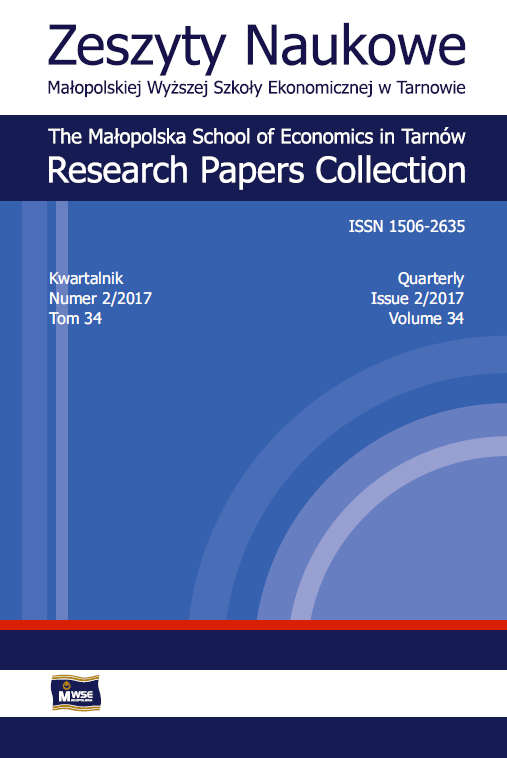Abstract
The purpose of this study is to identify variations between fertility rates in correlation to registered unemployment rates of different districts in the Wielkopolska region and to provide the type, direction, and strength of potential correlation between the two variables: birth rates and unemployment rates. This study hypothesizes that registered unemployment rates influence the fertility rates within the Wielkopolska region. The range of time covered by this study is between 1999 to 2015. The data used in this study was sourced from the Regional Data Bank (1999–2015) and is available on the Polish Central Statistical Office website. In the exploration stage, the fertility rates in 1999 were used as a base for all comparisons when describing the indices of the dynamics. To determine the impact of registered unemployment rates on total fertility rates, a two-way factorial regression analysis and correlational analysis were conducted. The results indicate that fertility rates between 1999 to 2015 varied, in terms of the relationship strength and direction, between the Wielkopolska’s districts. A similar pattern was discovered in relation to the registered unemployment rates. In the research process, the hypothesis confirmed a correlation between total fertility rates and registered unemployment rates. The regression models used described the fertility rates in relation to registered unemployment rates, in most of the districts, as linear and pointing in a negative direction. The coefficients of determination are differentiated by place of residence.
References
Balicki, J., Frątczak, E., Nam, Ch.B. (2007). Mechanizmy przemian ludnościowych: globalna polityka ludnościowa. Warszawa: Instytut Politologii Uniwersytetu Kardynała Stefana Wyszyńskiego. ISBN 8385737685.
View in Google Scholar
Bartosiewicz, S. (1989). Ekonometria: technologia ekonometrycznego przetwarzania informacji. Warszawa: PWE. ISBN 8320806461.
View in Google Scholar
Frątczak, E., Sobczak, I. (red.). (1999). Dzietność kobiet polskich w okresie transformacji ustrojowej: materiały z konferencji demograficznej Unieście/Koszalin, 18 i 19 września 1999 r. Warszawa: Polskie Towarzystwo Demograficzne Zarząd Główny. ISBN 8390191288.
View in Google Scholar
Frątczak, E. (2003). Przemiany płodności i rodziny w Polsce i Europie. Oceny, interpretacje, teorie, polityka rodzinna. W: Z. Strzelecki (red.). Polska a Europa: procesy demograficzne u progu XXI wieku. T. 17. I Kongres Demograficzny w Polsce: sesja końcowa, Warszawa, 25–26 listopada 2002 r. Warszawa: Rządowe Centrum Studiów Strategicznych. ISBN 8387427683.
View in Google Scholar
GUS. (2016). Baza Demografia [online, dostęp: 2017-03-22]. Warszawa: Główny Urząd Statystyczny. Dostępny w Internecie: http://demografia.stat.gov.pl/bazademografia/.
View in Google Scholar
GUS. (2017). Bank Danych Lokalnych [online, dostęp: 2017-03-22]. Warszawa: Główny Urząd Statystyczny. Dostępny w Internecie: https://bdl.stat.gov.pl/bdl/dane/podgrup/temat.
View in Google Scholar
Guzik, B. (1979). Propozycja zmodyfikowanego współczynnika determinacji dla doboru zmiennych objaśniających do modelu ekonometrycznego. Przegląd Statystyczny, 1–2, 67–78.
View in Google Scholar
Holzer, J.Z. (2003). Demografia. Warszawa: PWE. ISBN 8320814626.
View in Google Scholar
Keller, G., Warrack, B., Bartel, H. (1988). Statistics for Management and Economics: A Systematic Approach. Belmont, CA: Wadsworth Publishing Co. ISBN 0534086225.
View in Google Scholar
Kot, S.M., Jakubowski, J., Sokołowski, A. (2011). Statystyka. Warszawa: Difin. ISBN 9788376413495.
View in Google Scholar
Krzysztofiak, M., Luszniewicz, A. (1976). Statystyka. Warszawa: PWE.
View in Google Scholar
Kufel, T. (2004). Ekonometria: rozwiązywanie problemów z wykorzystaniem programu GRETL. Warszawa: Wydawnictwo Naukowe PWN. ISBN 8301142847.
View in Google Scholar
Okólski, M., Fihel, A. (2012). Demografia: współczesne zjawiska i teorie. Warszawa: Wydawnictwo Naukowe Scholar. ISBN 9788373836129.
View in Google Scholar
RRL. (2004). Sytuacja Demograficzna Polski. Raport 2002. Warszawa: Rządowa Rada Ludnościowa.
View in Google Scholar
Rosset, E. (1975). Demografia Polski. T. 2: Reprodukcja ludności. Warszawa: PWN.
View in Google Scholar
Wierzchosławski, S. (1993). Przeobrażenia demograficzne współczesnej Europy i perspektywy jej rozwoju. W: R. Domański (red.). Studia europejskie (s. 99–136). Poznań: Wydawnictwo Akademii Ekonomicznej.
View in Google Scholar
Witkowski, J. (2003). Rozwój ludności a rynek pracy. W: Z. Strzelecki (red.). Polska a Europa: procesy demograficzne u progu XXI wieku. T. 17. I Kongres Demograficzny w Polsce: sesja końcowa, Warszawa, 25–26 listopada 2002 r. Warszawa: Rządowe Centrum Studiów Strategicznych. ISBN 8387427683.
View in Google Scholar
© Copyright by Małopolska School of Economics in Tarnów. The articles are available under the Creative Commons Attribution NonCommercial-NoDerivatives 4.0 International License


